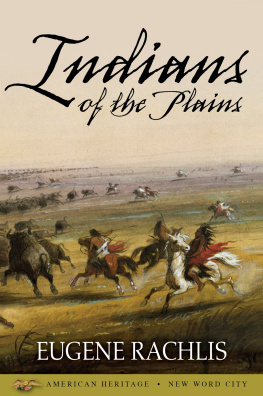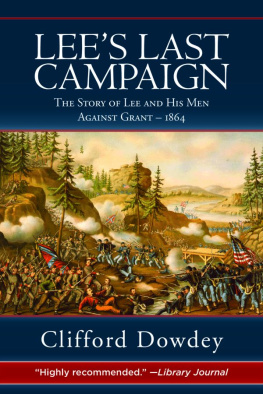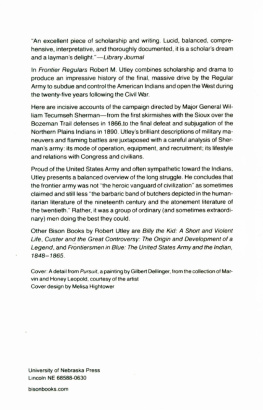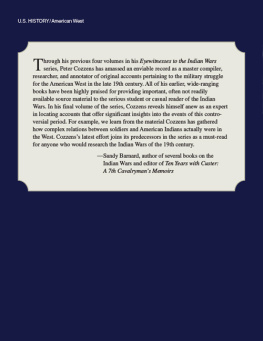Copyright 1973 by Robert M. Utley
All rights reserved
First Bison Book printing: September 1984
Library of Congress Cataloging in Publication Data
Utley, Robert Marshall, 1929
Frontier regulars.
Reprint. Originally published: New York: Macmillan, cl973.
Bibliography: p.
Includes index.
I. Indians of North AmericaWars18661895. 2. United States. ArmyHistory. 3. West (U.S.)History18481950. 4. United States. ArmyMilitary lifeHistory19th century. I. Title.
[E83.866.U87 1984] 973.8 847484
ISBN-13: 978-0-8032-9551-3 (paper: alk. paper)
ISBN-13: 978-0-8032-9568-1 (electronic: e-pub)
ISBN-13: 978-0-8032-9569-8 (electronic: mobi)
Reprinted by arrangement with Macmillan Publishing Company, Inc.
The publisher does not have any control over and does not assume any responsibility for author or third-party websites or their content.

ERRATA
| p. 25, 1. 28: | Merrit should be Merritt |
| p. 112, 1. 31: | restored should be resorted |
| p. 116, 1.6: | eleven troops should be eight troops |
| p. 118, 1. 29: | May 2 should be May 3 |
| p. 120, 1. 17: | August 2223 should be August 2122 |
| p. 132, 1. 23: | Department of Dakota, not the Dakota |
| p. 150, 1. 9: | Kansas should be Kansans |
| p. 155, 1. 33: | three chiefs should be four |
| p. 181, 1.2: | has should be had |
| p. 193, 1. 37: | Freedmans should be Freedmens |
| p. 296, 1. 19: | Same |
| p. 194, 1. 32: | Cohises should be Cochises |
| p. 205, 1. 23: | June 3 should be June 1 |
| p. 213, 1. 27: | wtih should be with |
| p. 230, 11. 20, 24: | Henely should be Heneley |
| p. 241, 1. 21: | Nabraska should be Nebraska |
| p. 246, 1. 24: | Serman should be Sherman |
| pp. 25354: | John S. Gray, Centennial Campaign, makes a persuasive case for fewer Indians than given here . |
| p. 260, 1. 7: | trumpeter orderly should be orderly trumpeter |
| p. 268, 1. 19: | Bonnett should be Bonnet |
| p. 303, 1. 9: | on should be of |
| p. 315, 1. 10: | Wallowa Valley |
| p. 323, 1. 14: | subsitute should be substitute |
| p. 326, 1. 10: | trial should be trail |
| p. 327, 1. 11: | Piautes should be Paiutes |
| p. 335, 1. 21: | Chief Douglas should be Chief Johnson |
| p. 351, 1. 16: | Zargosa should be Zaragosa |
| p. 362, 1. 14: | May 23 should be May 24 |
| p. 364, 1. 2: | 1,000 should be 350 |
| p. 364, 11. 1318: | should read trapped Victorio amid three peaks called Tres Castillos. Dead Indians numbered 62. Who fired fatal bullet not known . |
| p. 377, 1. 29: | guage should be gauge |
| p. 380, 1. 4: | Benito should be Bonito |
| p. 389, 1. 14: | bed should be bend |
| p. 407, 1. 28: | At should be as |
Introduction
I N A PREVIOUS volume of this series, I sketched the story of the handful of blue-clad frontiersmen who contended with the Indian tribes of the trans-Mississippi West in the years between the Mexican War and the Civil War. I also dealt with the Volunteers who replaced the Regulars during the Civil War years and who on almost every front stepped up the scale and effectiveness of warfare against the Indians. In the present volume my subject is the Regular Army that took up the task after Appomattox and carried the Indian Wars to their tragic and bloody conclusion at Wounded Knee Creek in 1890.
The frontier Regulars saw themselves as the advance guard of civilization, sweeping aside the savage to make way for the stockman, the miner, the farmer, and the merchant. This stereotype is evident in the writings of officers such as Nelson A. Miles, George A. Custer, George A. Forsyth, John G. Bourke, George F. Price, T. F. Rodenbough, James Parker, and William H. and Robert G. Carter; of officers wives such as Mrs. Custer, Mrs. Biddle, Mrs. Summerhayes, and Mrs. Boyd; and of friendly newsmen such as John F. Finerty. It is to be glimpsed in the art of Frederic Remington and Charles Schreyvogel. Above all, it is to be credited to Captain Charles King, who in dozens of novels reinforced the armys view of itself. King summed it up years later in an address to Indian War veterans:
It is all a memory now, but what a memory, to cherish! A more thankless task, a more perilous service, a more exacting test of leadership, morale and discipline no army in Christendom has ever been called upon to undertake than that which for eighty years was the lot of the little fighting force of Regulars who cleared the way across the continent for the emigrant and settler.
Others saw the Regulars in a different light. Eastern humanitarians assailed them as butchers, rampaging around the West gleefully slaughtering peaceable Indians and taking special delight in shooting down women and children. Antislavery leaders such as Wendell Phillips and William Lloyd Garrison turned energies liberated by the Emancipation Proclamation to a crusade in behalf of the red men, and the army felt the sting of rhetoric sharpened in the long war against the slavocracy. I only know the names of three savages upon the Plains, declared Phillips in 1870, Colonel Baker, General Custer, and at the head of all, General Sheridan. Bakers assault on a Piegan village in 1870 inspired a verse that typified the humanitarian stereotype of the army:
Women and babes shrieking awoke
To perish mid the battle smoke,
Murdered, or turned out there to die
Beneath the stern, gray, wintry sky.
Until recent years, the heroic stereotype of the frontier army dominated the collective memory of Americans. It found its most vivid expression in the motion pictures of John Ford and the characterizations of John Wayne. Today, however, a nation increasingly troubled by its historic treatment of the Indians has substituted the ugly for the heroic stereotype. In great quantities of popular literature, in television productions, and in motion pictures such as Little Big Man and Soldier Blue , the frontier Regulars are depicted as the nineteenth-century humanitarians saw them.
Each of the stereotypes contains some small truths and some large untruths. Just as campaigning troopers sported both black hats and white hatsand any other hue that suited their fancyso a fair appraisal of the Indian-fighting army must acknowledge a mix of wisdom and stupidity, humanity and barbarism, selfless dedication and mindless indifference, achievement and failure, triumph and tragedy; but above all, as in most human institutions, of contradictions and ambiguities. I hope that in the following pages the frontier Regulars emerge in a characterization that strikes a truthful balance between the two stereotypes.
An expression of gratitude is due the following people for reading all or part of the manuscript or for other helpful kindnesses: Louis Morton of Dartmouth College, editor of the series in which this volume appears; Francis Paul Prucha of Marquette University; Harry H. Anderson of the Milwaukee County Historical Society; Robert Murray, Gordon Chappell, and Verne Ray; Andrew Wallace of Northern Arizona University; Donald J. Berthrong of Purdue University; James S. Hutchins of the Smithsonian Institution; Sidney B. Brinckerhoff of the Arizona Historical Society; and my colleagues in the National Park Service, Franklin G. Smith, Merrill J. Mattes, Roy E. Appleman, Erwin N. Thompson, John D. McDermott, Edwin C. Bearss, and Albert H. Schroeder. Special thanks go to Walter T. Vitous of Olympia, Washington, for the maps.









